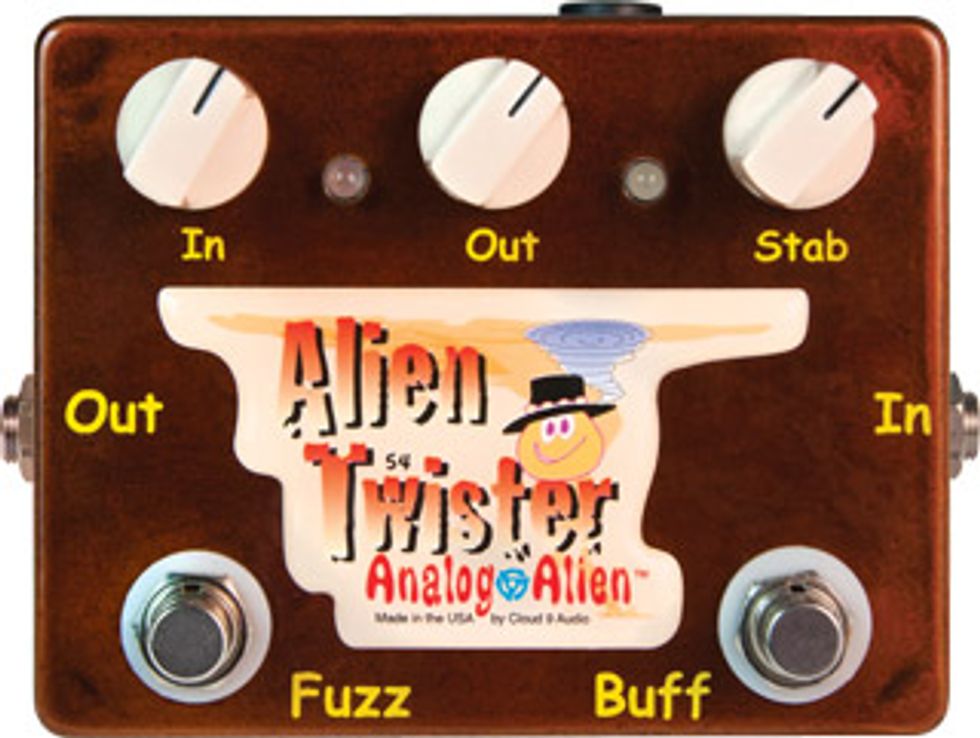The Alien Twister was inspired by the Diaz Texas Square Face pedal used by the late, great Stevie Ray Vaughan.

Nestled in a cloth satchel and wooden box, surrounded by hay, and accompanied by a bottle of hot sauce, the Alien Twister piques your curiosity before you ever lay a finger on the thing. The marketing line is that the Twister originated on a planet called Bliptone (a story that, frankly, calls into question the freshness of the condiments … ), but in reality the pedal comes from Long Island’s Cloud 9 Audio, a company that produces pedals under the Analog Alien name.
The hot sauce and logo depicting an alien wearing a conch-studded hat make more sense when you realize the Alien Twister was inspired by the Diaz Texas Square Face pedal used by the late, great Stevie Ray Vaughan. Inside, it contains fuzz, overdrive, and distortion circuits paired with a built-in buffer—all of which is of a piece with the planet hopping that UFO-driving aliens are famous for.
Twist ’Em Up
The Twister flits from overdrive
to fuzz via three knobs: In controls
input level, out controls
output level, and stab governs
the voltage sent to the final
transistor stage. The two blindingly
bright lights between the
knobs correspond to the pedal’s
fuzz and buff footswitches (purple
for fuzz and white for buff ).
I tested the Alien Twister with a Fender Select Telecaster and a Gibson Les Paul Standard played through a silverface Fender Princeton Reverb—a nice canvas for Texas tones and a good blank slate for fuzz explorations, too. Analog Alien, in fact, looked to the Fender Champ as reference for its overdrive voice. Though the pedal has a tone section, like many vintage fuzz boxes there’s no tone knob (the company says one may appear on a future edition). To tweak frequencies, you’ll need to get crafty with your amp’s EQ section and your guitar’s tone controls.
Set to the “vintage fuzz” settings in the manual—the in knob all the way up, out at unity gain (about 10 o’clock), and stab at 1 o’clock—the pedal yielded a meaty fuzz that was equally at home with lower-register single-note riffs, power chords, and leads on higher strings. Turning stab counterclockwise is the ticket to more radical terrain—it lets you create a glitchy, almost synth- or ring-modulator-like cutting-out effect that’s in keeping with pedal’s claim to interplanetary origins.
The suggested “lead distortion” and “overdrive” settings involve moving stab all the way clockwise, resulting in increased sustain and note clarity. This produced a rich, detailed, and throaty voice that’s the stuff of lead-tone dreams. However, the noticeable increase in articulation means you can’t hide behind pedal mush. One strange quirk: With stab cranked, there’s a noticeable increase in volume as a held note starts to decay. (Analog Alien says this is due to natural compression at such levels.)
Ratings
Pros:
Great fuzz and dirt tones can cover earthy
and extraterrestrial territory.
Cons:
The stab knob can be tricky if you like
simpler fuzz circuits.
Tones:
Ease of Use:
Build:
Value:
Street:
$199
Analog Alien
analogalien.com
Given that you get unity gain with out at 10 o’clock, the Alien offers plenty of headroom for driving even the most anemic pickups. And no matter what type of guitar I used, it enabled me to dial up a beefy tone that never got woofy or muddy.
Without the buffer engaged, the Alien Twister runs as a true-bypass circuit. But true bypass is no panacea for signal theft—if there’s a lot of cable between a bunch of true-bypass pedals, there will be signal loss. A buffer converts the signal from high to low impedance to allow the signal to maintain sonic integrity through long cables or signal paths without adding gain. I had about 25 feet of cable between my guitar, pedal, and amp, and when I engaged the buff footswitch there was a noticeable increase in brightness when the fuzz was engaged and inactive. It’s a useful addition that makes an already very adaptable pedal even more so.
The Verdict
With a rich fuzz, fat overdrive,
and big distortion sounds all in
one box, the Alien Twister can
thoroughly cover sounds ranging
from stoner rock to voodoo
blues, noise and experimental,
and rowdy, straight-ahead rock
’n’ roll. Add in the very practical
buffer, and you’ve got a
stompbox that could render
at least a few residents of your
pedalboard obsolete. And if
you’re into the idea of consolidating
pedal functions and
exploring more unique fuzz
and overdrive hues, the Alien
Twister is more than able to
whip up the weather.
